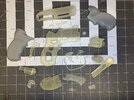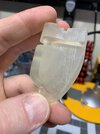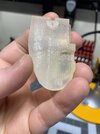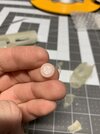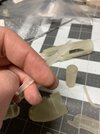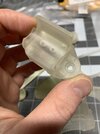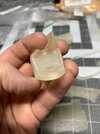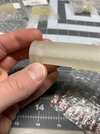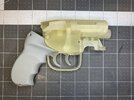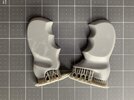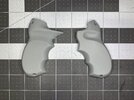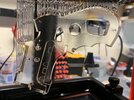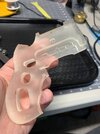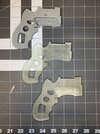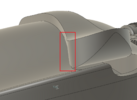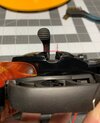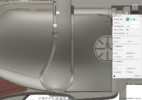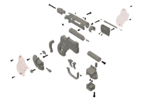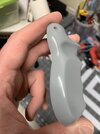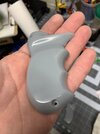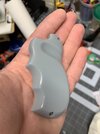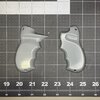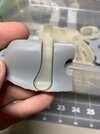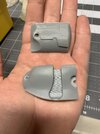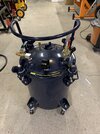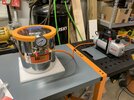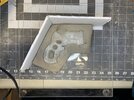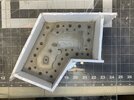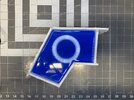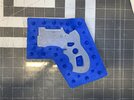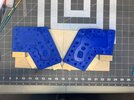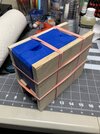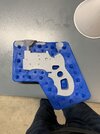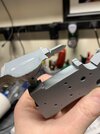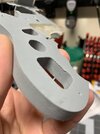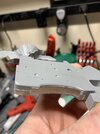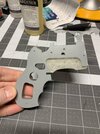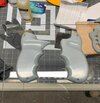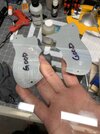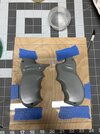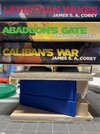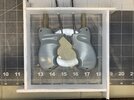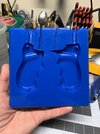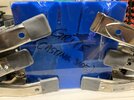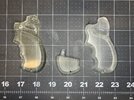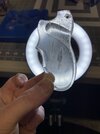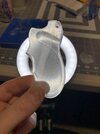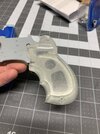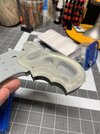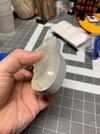So before everyone gets so sick of Blade Runner blaster and snub-nosed blaster posts they just tell me to take it the hell over to Propsummit already I figured I'd post about my own snub blaster build.
veektohr once described Luke's saber as "a perfect object". This is an accurate description of my feelings about the Blade Runner blaster, but more importantly for this post, also about Dave Goldberg's fantastic snub-nosed blaster design.
Having missed the original run of Dave's blasters by about 5 years at the time I first discovered it, however, I decided to set about trying to recreate it for myself, collecting every stitch of reference material I could about it from across the web.
My goal was to model the blaster exactly as he had in Rhino, matching his progress shots as best I could, tweaking things endlessly until everything looked as accurate as possible (also on the agenda: learn Rhino).
A comparison of the most complete version of Dave's original 3D model he ever posted and my version next to it, representing roughly a year and a half of on-again, off-again effort:
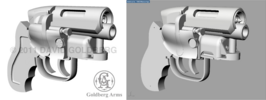
And the all-important superimposed wireframe:
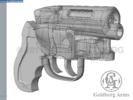
From the beginning I knew that while I wanted the overall shape and design to be as close as possible, I had a few subtle changes I intended to make as well. For the writing and iconography I opted for a scaled-down/modified version of the Steyr-based elements on the big-brother PKD, similarly using almost exclusively hex-head cap screws as opposed to the fillister screws on Dave's original snub. I also knew I wanted to try to do a functional bolt and triggers on mine and that's why, a year and a half into the project, I migrated the whole mess into Fusion 360... which eventually led me to here:
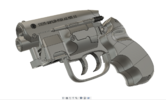
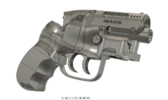
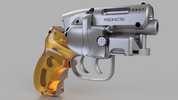
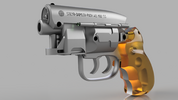
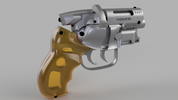
So, a few weeks ago, after tinkering with this thing on and off for 4 years, I finally sent the whole mess off to Shapeways to have it printed. The box literally just arrived this afternoon and I absolutely haven't posted about this before now because, while a pretty 3D model is great and all, I wanted to have something physical to show for it before I went calling it a "project".
Alas, parenthood calls, so part 2 will have to wait until later tonight.
veektohr once described Luke's saber as "a perfect object". This is an accurate description of my feelings about the Blade Runner blaster, but more importantly for this post, also about Dave Goldberg's fantastic snub-nosed blaster design.
Having missed the original run of Dave's blasters by about 5 years at the time I first discovered it, however, I decided to set about trying to recreate it for myself, collecting every stitch of reference material I could about it from across the web.
My goal was to model the blaster exactly as he had in Rhino, matching his progress shots as best I could, tweaking things endlessly until everything looked as accurate as possible (also on the agenda: learn Rhino).
A comparison of the most complete version of Dave's original 3D model he ever posted and my version next to it, representing roughly a year and a half of on-again, off-again effort:

And the all-important superimposed wireframe:

From the beginning I knew that while I wanted the overall shape and design to be as close as possible, I had a few subtle changes I intended to make as well. For the writing and iconography I opted for a scaled-down/modified version of the Steyr-based elements on the big-brother PKD, similarly using almost exclusively hex-head cap screws as opposed to the fillister screws on Dave's original snub. I also knew I wanted to try to do a functional bolt and triggers on mine and that's why, a year and a half into the project, I migrated the whole mess into Fusion 360... which eventually led me to here:





So, a few weeks ago, after tinkering with this thing on and off for 4 years, I finally sent the whole mess off to Shapeways to have it printed. The box literally just arrived this afternoon and I absolutely haven't posted about this before now because, while a pretty 3D model is great and all, I wanted to have something physical to show for it before I went calling it a "project".
Alas, parenthood calls, so part 2 will have to wait until later tonight.

